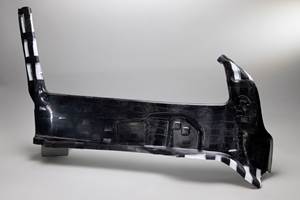SAMPE 2018 keynote looks to the composites future
The SAMPE 2018 general session featured the announcement of the top three papers presented at the conference, and a keynote by Carmelo Lo Faro, president, Solvay Composite Materials (Alpharetta, FA, US).
The SAMPE 2018 general session featured the announcement of the top three papers presented at the conference, and a keynote presented by Carmelo Lo Faro, president, Solvay Composite Materials (Alpharetta, GA, US).
The top three papers were:
- First place: “Fabrication of Out-of-Autoclave Prepreg with High Through-Thickness Permeability by Polymer Film Dewetting,” Sarah G. K. Schechter, Timotei Centea and Steven R. Nutt
- Second place: “Warpage of Thin-Gauge Compression-Molded Panels with Discontinuous Long Fiber Carbon/Polyetheretherketone,” Caroline Collins and Pascal Hubert
- Third place: “Recycling of Amine/Epoxy Composites Using Chemical Treatment at Atmospheric Pressure,” Yijia Ma, Travis J. Williams and Steven R. Nutt
For his keynote, Lo Faro surveyed the materials evolution, from copper in 8700 BC, straw/mud bricks in 2500 BC, steel in 1851 AD, aluminum in 1889, titanium in 1950, to the evolution of composites in the 1950s and 1960s, followed by the growth of aerospace technologies (1970-2010) in commercial and defense-related breakthroughs.
With that as context, he spoke about three ‘eras’ of composites: The lightweighting era (1970-1995), the manufacturing era (1995-today) and the next era, which he deemed the industrialization and simulation era.
He pointed out that automation of manufacturing processes has been a significant enabler of composites construction in the commercial aircraft structures arena. Today’s infusion technology enhances affordability and results in a viable manufacturing rate, he added, citing Bombardier’s (Montreal, QC, Canada) C Series wing, made with high-pot-life resin and non-crimp fabric. He highlighted the CFM LEAP engine fan blade, made using toughened resin and 3D woven preforms; and Moscow, Russia-based Irkut’s MS-21 wing, made via automated fiber placed dry tape infused with toughened resin. “I don’t believe aluminum and titanium accomplished as much in their first 30 years as composites have in their first 30 years,” he argued.
Can we claim victory? Lo Faro asked. In short, he answered, no — a lot more can be done. To grow further, composites must deliver more value, he said. Future challenges and opportunities might include press forming, thermoplastic composites for large structures, additive manufacturing, joining, simulation, managing complexities, and, of course, cost.
LoFaro did inject “a little caveat — the hype cycle,” where interest becomes exaggerated enthusiasm (hype), and then, “after a time of disillusionment,” finds its place in reality. The future, he said, will be driven by industrial scale and economies; convergence of aerospace and automotive practices; and the increased importance of production systems vs. end-products.
Moving on to thermoplastic composites, Lo Faro discussed PEEK, PEKK, PAEK and continuous compression molding. Thermoplastic composites are not new, he reminded his listeners. Further, he expects growth in the 21st Century to be enabled by maturation of cost-effective, automotive-like manufacturing processes developed in the past 15 years: notably compression molding, continuous compression molding and stamp forming. If the aerospace supply chain is to develop and build large thermoplastic composite structures then it must mature out-of-autoclave molding/forming systems capable of rapid heating/cooling.
Lo Faro also touched on additive manufacturing (AM). Initially, he said, AM can support manufacture of tooling and fixtures. In the future, AM can provide on-demand tool manufacturing, and can improve composites maintenance and repair operations (MRO). Here too, he said, are opportunities to couple AM with machine learning. However, he said, more collaboration is needed between machine and material suppliers.
Lo Faro went on to name three important simulation and modeling needs for the composites industry:
- Molecular modeling — informing experimentation and increasing speed to market
- Artificial intelligence — applied to materials design and discovery
- Certification by analysis — which he called the Holy Grail
These technologies have the potential to shorten development time through optimized molecular design for improved properties, changing the way the materials themselves are developed. The future is now, he said, for multi-scale modeling to accelerate composites innovations and adoption and failure prediction.
Lo Faro finished optimistically: “When we look at the next 40 years, I believe composites are a material that will exceed the capabilities of metals.”
Related Content
3D weaving capabilities achieve complex shapes, reduce weight and cost
JEC World 2024: Bally Ribbon Mills is displaying film-infused 3D woven joints, woven thermal protection systems (TPS) and woven composite 3D structures.
Read MoreComposite resins price change report
CW’s running summary of resin price change announcements from major material suppliers that serve the composites manufacturing industry.
Read More3D-woven composites find success in aerospace, space
CAMX 2024: Bally Ribbon Mills experts are displaying the company’s various joints, thermal protection system (TPS) technologies and other 3D woven composites for mission-critical applications.
Read MoreHighly tunable, woven lattice reinforcements target automotive structures
CAMX 2023: Startup Weav3D will be demonstrating its two collaborative automotive demonstrator parts and present two conference papers.
Read MoreRead Next
“Structured air” TPS safeguards composite structures
Powered by an 85% air/15% pure polyimide aerogel, Blueshift’s novel material system protects structures during transient thermal events from -200°C to beyond 2400°C for rockets, battery boxes and more.
Read MoreDeveloping bonded composite repair for ships, offshore units
Bureau Veritas and industry partners issue guidelines and pave the way for certification via StrengthBond Offshore project.
Read MoreVIDEO: High-volume processing for fiberglass components
Cannon Ergos, a company specializing in high-ton presses and equipment for composites fabrication and plastics processing, displayed automotive and industrial components at CAMX 2024.
Read More












.jpg;maxWidth=300;quality=90)








